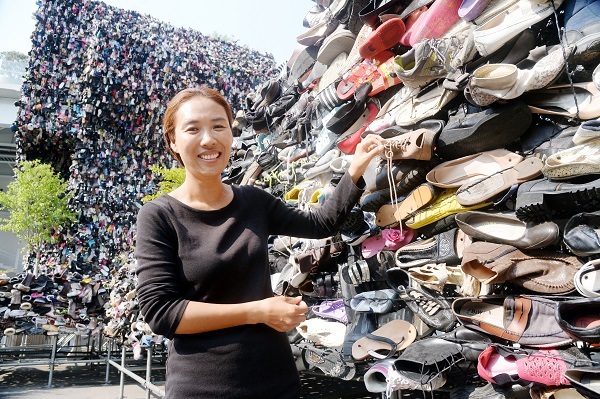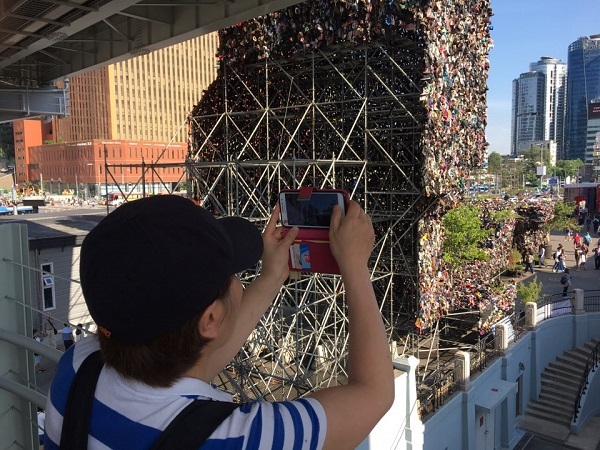[Herald Interview] Artist behind controversial ‘Shoes Tree’ talks about her work
By Kim Da-solPublished : May 23, 2017 - 15:53
Even before Shoes Tree, a giant art installation made from thousands of worn-out shoes, was officially unveiled in front of Seoul Station, it drew mixed responses.
Some called it a giant pile of garbage. Others, refraining from premature judgment, expressed curiosity over its artistic intention and meaning.
The artist, Hwang Ji-hae, sat down with The Korea Herald on Monday, two days after its unveiling Saturday, to discuss her work.
Some called it a giant pile of garbage. Others, refraining from premature judgment, expressed curiosity over its artistic intention and meaning.
The artist, Hwang Ji-hae, sat down with The Korea Herald on Monday, two days after its unveiling Saturday, to discuss her work.

“Each of these shoes, whether they are high heels, baby shoes, sandals or running shoes, carry different stories, memories and meanings of those who wore them.
“And we all wear shoes,” said the 39-year-old artist.
Nearly 30,000 shoes form cascading tree bushes, decorated with plants and flowers, just outside Seoul Station, in celebration of the grand opening of Seoullo 7017, an old overpass-turned-public park. It was a pro-bono work by Hwang, an internationally recognized garden designer and environmental artist.
In 2012, she won the gold medal at the 2012 Chelsea Flower Show with her work “Quiet Time: DMZ Forbidden Garden.” A year before, she won the same award by turning a traditional Korean bathroom into a garden, called “Hae-woo-so.”
Her previous works featured naturalized planting, old military shoes, sand mold for casting metals and a bunch of twigs, Hwang said.
“But on top of that, my favorite material to work with is bolt nuts. They are cheap and easily found.”
The reason why Hwang specifically picked shoes this time was to highlight the meaning of urban restoration to visitors of Seoullo 7017.
“Both ‘Shoes Tree’ and Seoullo 7017 are given new life with new meanings, reborn as a creative upcycling art and a unique park, respectively.”
She added that using shoes to create a tree was to remember the historical significance of the Yeomcheon-gyo handmade shoes street, located behind Seoullo 7017.

But her selection of shoes for art material was primarily because she believed shoes reflected the connection between herself, her art and the public.
“Through shoes, something we wear every day and an easy material to get, I wanted to show people that everyday material can also become part of art.”
From the early stage of installation, however, Shoes Tree was at the center of controversy.
“At first, I thought it was a pile of garbage,” said 49-year-old Kim Gui-ri.
“Looking at it up close, it is surely a garbage mountain and smells really bad,” Kim said.
Cho Sook-hyun, a local freelance art journalist, said that “the idea of recycling worn-out materials is creative, but since it was created as public art, which must at first give joy and have a healing effect on citizens, I personally think ‘Shoes Tree’ does not serve its purpose correctly.”
There are also many who appreciate it as a creative artwork.
“Since art is not something that must be always beautiful or contain an aesthetic side, I think ‘Shoes Tree,’ as a work of art itself, can portray a different perspective of appreciating art,” said freelance artist surnamed Kim.
Hwang expressed regret about people’s negative reviews because it was made of untidy, worn-out shoes and didn’t help Seoul look prettier.
“Many probably felt unfamiliar and uncomfortable looking at ‘Shoes Tree,’ because they have never thought that shoes could be part of art. I understand people appreciate art in different ways,” Hwang said.
The artist stressed that she wanted to make a strong impression on viewers with the artwork.
“Since Shoes Tree will be removed after nine days, I wanted to make it strong and impressive during a short period of time. I hope Shoes Tree speaks for who I am as an artist,” Hwang said.
“I could have used golden bars to lure the public and make a good impression, don’t you think? My art is always an attempt to communicate with the public.”
By Kim Da-sol (ddd@heraldcorp.com)








![[Kim Seong-kon] Democracy and the future of South Korea](http://res.heraldm.com/phpwas/restmb_idxmake.php?idx=644&simg=/content/image/2024/04/16/20240416050802_0.jpg&u=)








![[KH Explains] Hyundai's full hybrid edge to pay off amid slow transition to pure EVs](http://res.heraldm.com/phpwas/restmb_idxmake.php?idx=652&simg=/content/image/2024/04/18/20240418050645_0.jpg&u=20240418181020)

![[Today’s K-pop] Zico drops snippet of collaboration with Jennie](http://res.heraldm.com/phpwas/restmb_idxmake.php?idx=642&simg=/content/image/2024/04/18/20240418050702_0.jpg&u=)